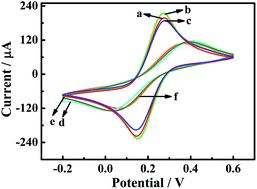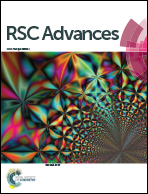Hemin/G-quadruplex DNAzyme nanowires amplified luminol electrochemiluminescence system and its application in sensing silver ions
Abstract
Herein, a DNA biosensor with a hemin/G-quadruplex DNAzyme amplified luminol electrochemiluminescence (ECL) system was constructed for sensing silver ions (Ag+). The cytosine (C)-rich capture DNA was first assembled on an electrodeposited gold nanoparticle (dep Au)-modified electrode. With specific base-pairing, the primer DNA was assembled on the electrode, which thus triggered hybridization chain reaction (HCR) to in situ produce long hemin/G-quadruplex DNAzyme nanowires. In the electrolyte containing H2O2 and luminol, the hemin/G-quadruplex exhibited superior horseradish peroxidase (HRP)-like activity and catalyzed H2O2 to quickly produce abundant reactive oxygen species (ROSs), which could greatly enhance the ECL intensity of luminol. Since Ag+ could mediate the C–C mismatch to form a stable C–Ag+–C complex between two neighboring C-rich capture DNA, the DNA nanochains gradually moved away from the electrode with the increase of Ag+ concentration, which resulted in a decreased ECL intensity for quantitative detection. According to the experimental results, the proposed DNA biosensor showed a linear range from 2 pM to 20 μM and exhibited excellent sensitivity and selectivity in the detection of Ag+.


 Please wait while we load your content...
Please wait while we load your content...